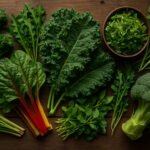Protein has always been a pillar of good nutrition, but in 2026, it takes center stage in the health and wellness space. Whether you’re looking to build lean muscle, support metabolism, manage weight, or simply feel fuller longer, high protein ingredients are a must-have in your kitchen.
With the evolving science of nutrition and a growing emphasis on sustainable, whole-food eating, the spotlight in 2026 is on nutrient-dense, clean, and high-quality protein sources. From plant-based innovations to supercharged traditional ingredients, this guide explores the smartest ways to power your meals with high protein ingredients for healthy recipes that align with today’s needs.
Why Protein is Essential in 2026
In a post-pandemic era of health awareness and functional nutrition, protein is more than just a muscle-builder — it’s a vital tool for immune health, hormone balance, and cellular repair.
Emerging trends in 2026 emphasize three pillars of protein consumption:
-
Quality over quantity: Complete amino acid profiles, bioavailability, and low inflammatory responses.
-
Sustainability: Ethical sourcing and reduced environmental impact.
-
Functional benefits: Gut health support, cognitive enhancement, and anti-aging properties.
Key Benefits of Protein in 2026:
| Benefit | Details |
|---|---|
| Muscle Preservation | Especially vital in aging populations or sedentary lifestyles |
| Appetite Control | Promotes satiety and reduces overeating |
| Metabolism Boost | Thermic effect of protein supports fat loss |
| Recovery | Crucial in post-workout and injury recovery |
| Skin, Hair, Nails | Structural support from collagen and keratin-rich sources |
“The conversation in 2026 isn’t just about hitting your macros. It’s about the quality of your macros — and protein is leading that shift.” — Dr. Lucia Renner, Functional Nutritionist
Understanding Protein Needs in Modern Diets
Not all protein consumption goals are the same. Age, activity level, health goals, and dietary choices all influence how much and what kind of protein you should consume.
Recommended Protein Intake (2026 Guidelines):
| Demographic | Daily Requirement (g/kg body weight) |
|---|---|
| Sedentary Adults | 0.8 – 1.0 g |
| Active Adults | 1.2 – 1.8 g |
| Athletes | 1.8 – 2.2 g |
| Elderly (65+) | 1.2 – 2.0 g |
| Pregnant Women | +25 g/day |
Misconceptions to Avoid:
-
More is not always better: Excess protein without balance can strain kidneys or displace other vital nutrients.
-
All protein is not equal: Plant-based sources may need to be combined for completeness.
-
Only bodybuilders need high protein: False — protein supports mental clarity, metabolic health, and aging gracefully.
A Balanced Approach
Aim for even protein distribution throughout the day. Instead of stacking all protein into dinner, try:
-
25–30g per meal for steady energy and muscle synthesis.
-
Include snack-sized doses (10–15g) with nuts, yogurt, or protein bars.
Plant-Based High-Protein Ingredients for Healthy Recipes in 2026
With the rise of flexitarian and vegan lifestyles, 2026 has seen an explosion of plant-based protein innovations. These ingredients are now formulated not only for protein content but also for digestibility, amino acid profile, and culinary versatility.
Top Plant-Based High Protein Ingredients:
| Ingredient | Protein (per 100g) | Highlights |
|---|---|---|
| Tempeh | 19g | Fermented, gut-friendly, complete protein |
| Lentils | 9g | High in iron, fiber, and folate |
| Edamame | 11g | Whole soybeans rich in antioxidants |
| Hemp Seeds | 32g | Rich in omega-3s and magnesium |
| Chickpea Flour | 22g | Versatile in baking and frying |
| Seitan | 25g | Wheat-based, meaty texture, low fat |
| Pea Protein Isolate | 80–90g | Used in shakes, bars, baked goods |
Tips to Maximize Plant Protein Efficiency:
-
Combine sources: Beans + grains (e.g., rice + black beans) create a complete amino acid profile.
-
Use fermentation: Fermented plant proteins (e.g., tempeh, miso) improve bioavailability.
-
Sprouting and soaking: Reduce antinutrients like phytic acid and increase nutrient absorption.
Real-World Recipe Example:
Power Bowl with Quinoa, Roasted Chickpeas, and Tahini-Hemp Dressing
-
22g protein per serving
-
Packed with fiber, antioxidants, and complete plant protein
-
Great for lunch or meal prep
Animal-Based High-Protein Ingredients for Healthy Recipes
Animal proteins remain essential for many due to their complete amino acid profiles and high bioavailability. In 2026, ethical sourcing, lean cuts, and antibiotic-free labels are top priorities for health-conscious consumers.
Top Animal-Based Protein Sources:
| Ingredient | Protein (per 100g) | Benefits |
|---|---|---|
| Chicken Breast | 31g | Lean, versatile, low fat |
| Turkey Breast | 29g | Lower in saturated fat than red meat |
| Eggs | 13g | Highly bioavailable, rich in choline |
| Cottage Cheese (Low-Fat) | 11g | High in casein, great for overnight recovery |
| Wild-Caught Salmon | 25g | Rich in omega-3s and anti-inflammatory |
| Tuna | 30g | Low calorie, high protein option |
| Grass-Fed Beef (Lean Cut) | 26g | Iron-rich, with CLA and B12 |
Quick Tip: Combine animal proteins with plant sides (like quinoa or lentil salads) for nutrient diversity and fiber balance.
Functional Protein Superfoods Gaining Popularity in 2026
Functional foods are now at the forefront of nutrition, offering more than just protein — they come with added benefits like gut health support, cognitive boosts, and immune defense.
Trending Functional Protein-Rich Ingredients:
-
Miso – fermented soybean paste packed with probiotics and umami flavor.
-
Tempeh – provides protein and natural enzymes that aid digestion.
-
Amaranth & Teff – ancient grains with complete protein profiles.
-
Kefir – a fermented dairy drink high in both protein and beneficial bacteria.
-
Spirulina – algae-derived, 60–70% protein by weight, with B12 and iron.
“In 2026, your protein source doesn’t just build muscle — it builds resilience.”
— Dr. Sienna Clarke, Gut-Immune Researcher
These ingredients are showing up in everything from smoothie blends to snack bars, proving that food can be both functional and flavorful.
Innovative Protein Sources: The Future is Now
Innovation is accelerating in food tech, and the protein landscape is evolving to meet climate and health demands.
Disruptive High Protein Ingredients in 2026:
| Source | Protein Content | Key Benefits |
|---|---|---|
| Cricket Flour | 60–70g per 100g | Sustainable, complete protein |
| Lab-Grown Chicken | 20–25g | No antibiotics, cruelty-free |
| Fermented Microbial Protein (e.g., Mycoprotein) | 15–18g | High fiber, low carbon footprint |
| Spirulina & Chlorella | 57g+ | Vegan, rich in micronutrients |
| Duckweed (Water Lentil) | 45g | High in leucine and iron |
These may still be niche in some markets, but they’re growing fast due to eco-conscious demand and culinary curiosity.
High-Protein Ingredients for Specific Diets
Whether you’re keto, vegan, paleo, or Mediterranean, 2026 offers more flexible, inclusive high-protein ingredients than ever.
Dietary Breakdown:
| Diet | Recommended High Protein Ingredients |
|---|---|
| Keto | Eggs, fatty fish, grass-fed beef, whey protein |
| Vegan | Seitan, tofu, tempeh, legumes, pea protein |
| Paleo | Cage-free eggs, game meats, nuts, seeds |
| Mediterranean | Lentils, chickpeas, yogurt, sardines |
Pro tip: Adapt recipes to your lifestyle — cauliflower rice with grilled tempeh works for both vegan and keto (with tweaks).
Cooking Techniques That Preserve Protein Quality
How you prepare protein matters just as much as which ingredients you choose.
Best Cooking Methods:
-
Sous Vide – preserves moisture and amino acid integrity.
-
Grilling or Baking – avoids added fats and retains nutrients.
-
Steaming – especially effective for fish and tofu.
-
Slow Cooking – great for legumes, collagen-rich cuts, and stews.
Avoid:
-
Deep-frying – denatures proteins and adds unhealthy fats.
-
Microwaving in plastic – potential leaching of toxins.
Sample High-Protein Recipes Using Top Ingredients
Bring these protein ingredients to life with easy, high-impact recipes.
1. Grilled Tempeh Quinoa Salad
-
Tempeh (19g), Quinoa (8g), Chickpeas (7g)
-
Total Protein: 34g per serving
2. Seared Salmon with Amaranth Pilaf
-
Salmon (25g), Amaranth (9g)
-
Total Protein: 34g
3. Spirulina Green Smoothie
-
Spirulina (5g), Hemp Seeds (8g), Greek Yogurt (10g)
-
Total Protein: 23g
These recipes are high-protein, anti-inflammatory, and nutrient-dense — perfect for active lifestyles.
Ingredient Sourcing and Sustainability in 2026
In 2026, consumers prioritize where and how their protein is sourced. Transparency is key.
Look for:
-
Certified Organic or Regenerative Labels
-
MSC-Certified Wild Fish
-
Pasture-Raised or Grass-Fed Meats
-
Fair Trade and Non-GMO Seals
Shop from:
-
Farmers markets
-
Direct-to-consumer platforms (like Thrive Market or ButcherBox)
-
Local co-ops with traceable sourcing
Support brands that align with your health and the planet.
Tips to Incorporate More Protein Easily
Adding more protein to your meals doesn’t have to mean meal prep marathons or expensive powders.
Easy Strategies:
-
Swap white rice for quinoa or lentil pasta
-
Use Greek yogurt instead of sour cream or mayo
-
Add tofu cubes to soups or curries
-
Sprinkle hemp seeds over cereal or salads
-
Sneak protein powder into pancake or waffle batter
Small upgrades lead to big results.
Conclusion: Eating Smart with Protein for a Healthier Future
The way we eat protein has changed — not just in quantity but in quality, purpose, and sustainability. The best high-protein ingredients for healthy recipes in 2026 are those that:
-
Fit your body’s needs
-
Support the environment
-
Deliver more than just grams — they deliver health
Whether you’re meal-prepping for the week or making dinner from scratch, you now have the tools, knowledge, and ingredients to create food that fuels your life — intelligently, deliciously, and sustainably.
“The future of food is functional, and protein is leading the way.”




